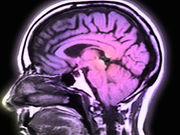Specific differences found in the brains of those who attempt suicide and those who do not
TUESDAY, Jan. 31, 2017 (HealthDay News) — Among adolescents and young adults with bipolar disorder, those who attempt suicide show reduced volume and activity in areas of the brain that regulate emotion and impulses, according to a study published online Jan. 31 in the American Journal of Psychiatry.
Using magnetic resonance imaging, Hilary Blumberg, M.D., of Yale University in New Haven, Conn., and colleagues compared regional gray matter volume, white matter integrity, and functional connectivity during processing of emotional stimuli in adolescents and young adults with bipolar disorder. Twenty six participants had a prior suicide attempt and 42 had no history of a suicide attempt.
The researchers found that, compared with those who had not attempted suicide, those who had attempted suicide exhibited significant reductions in gray matter volume in the orbitofrontal cortex, hippocampus, and cerebellum; white matter integrity in the uncinate fasciculus, ventral frontal, and right cerebellum regions; and amygdala functional connectivity to the left ventral and right rostral prefrontal cortex.
“The findings suggest that the frontal cortex is not working as well as it should to regulate the circuitry,” Blumberg said in a Yale news release. “The identification of brain circuits involved in risk for suicide can lead to new ways to identify who is most at risk and, hopefully, prevent suicides.”
Full Text (subscription or payment may be required)
Copyright © 2017 HealthDay. All rights reserved.








